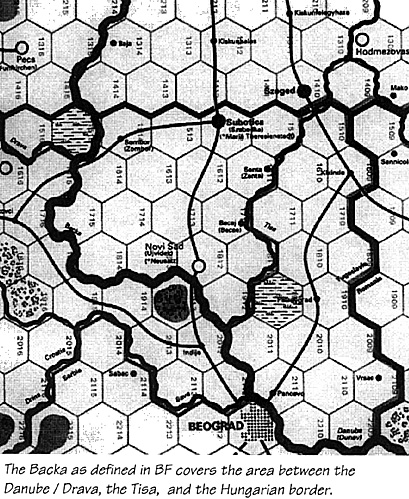 While playing Balkan Front, Karl Soderholtz, Bob Lilly, and I
noticed something we thought was strange. The Hungarian forces are
restricted to the Backa region of Yugoslavia. To review, the Backa region
of Yugoslavia is the area on map 14A between the Danube (and Drava)
and Tisa rivers and the Hungary-Yugoslavia border (from 14A:1511 to
14A:1516). It totals 19 hexes and contains: the dot city of Subotica
(14A:1512), the reference city of Novi Sad (14A:1812), the two point
cities Sombor (14A:1514) and Senta (14A:1611), and a swamp hex
(14A:1515). Nice area, however this leaves the following 11 hexes on
the Hungary-Yugoslavia border "safe" for the Yugoslavs: 14A:0721,
14A:0821, 14A:0921, 14A:1020, 14A:1120, 14A:1219, 14A:1319,
14A:1418, 14A:1518, 14A:1517, and 14A:1510. By "safe" I mean
the Hungarians can not attack into them. Three major rail lines cross this
"safe" border.
While playing Balkan Front, Karl Soderholtz, Bob Lilly, and I
noticed something we thought was strange. The Hungarian forces are
restricted to the Backa region of Yugoslavia. To review, the Backa region
of Yugoslavia is the area on map 14A between the Danube (and Drava)
and Tisa rivers and the Hungary-Yugoslavia border (from 14A:1511 to
14A:1516). It totals 19 hexes and contains: the dot city of Subotica
(14A:1512), the reference city of Novi Sad (14A:1812), the two point
cities Sombor (14A:1514) and Senta (14A:1611), and a swamp hex
(14A:1515). Nice area, however this leaves the following 11 hexes on
the Hungary-Yugoslavia border "safe" for the Yugoslavs: 14A:0721,
14A:0821, 14A:0921, 14A:1020, 14A:1120, 14A:1219, 14A:1319,
14A:1418, 14A:1518, 14A:1517, and 14A:1510. By "safe" I mean
the Hungarians can not attack into them. Three major rail lines cross this
"safe" border.
Now let me explain to you what started the whole question of the Hungarian stop line. Let me interject that in the following example I will talk about the Hungary 4" and 5" Corps, a habit from my army days. These corps are represented by the corps markers each consisting of:
- 4th Corps
- 3x 4-6 Inf XX
1x 3-8* mot Inf X
1x 3-8 Cav X
1x 2-1-8 Art X
5th Corps
- 3x 4-6 Inf XX
1x 3-8* mot Inf X
1x 3-8 Cav X
1x 1-8 Eng III
The 4th Corps started in Kiskunhalas (14A:13 12) and the 5 1h Corps started in Kiskunfelegyhaza (14A:1210). When the Germans intervened on Apr I, the 4" and 5 th corps moved to 14A:1412 and Szeged (14A:1410), respectively, and attacked across the border into Subotica (14A:1512) and 14A:1510, again respectively. The attacks were successful and cleared the rail lines; both corps advanced after the attack. On Apr II, the 4th moved through 14A:1612, 14A:1613, 14A: 1714, and finally into 14A:1813 on the western side of Novi Sad (14A:1812). By the way, Bob chose to make a major stand at Novi Sad (14A: 1812). Meanwhile, the 5th moved through 14A:1610, 14A:1711, and across the Tisa river into 14A:1811 on the eastern side of Novi Sad (14A:1812). This is a standard pincer movement, the Yugoslavs have no retreat, and the attack was successful. On May I, I checked for Hungarian stop line and found that my line of advance for the 5th included 3 hexes outside of the Backa, 14A:1510, 14A:1610, 14A: 1711.
After the game, we talked about the limits on the Hungarians. Before going on let us look at the factors that may have played into the present rule. First, historically this is the area (the Backa) that the Hungarians did invade. Also historically, the whole German invasion of Yugoslavia took about 3 weeks, leaving no time for the Hungarians to really do anything. Second, politically the Hungarians were really only interested in taking back "lost territory". And lastly, logistically the Hungarians had a poor supply system, remember the Hungarians depended on the Germans for supplies in Russia. We decided that any recommendation for a new stop line had to include the previously listed factors. So we came up with the following:
On the turn of the German intervention: Hungarian units may operate in an area Northeast of the Danube river to the Romanian border.
After the turn of the German intervention: Hungarian units may operate in the area north of the Danube river between the Romanian border to the Sava river, northeast of the Sava river from the Danube river to the head of the river (14A:0825), north of the Slovenia-Slovenia regional border (14A:0826 to 14A:0827) from the head of the Sava river to the Italian border.
This allows the Axis player freedom of movement, while maintaining logistical restrictions. It also concurs with the politics of the time by starting the Hungarians retaking "stolen territory". If the game ends as quickly as the operation actually did, the Hungarians really do not have time to do much more and this maintains the historical flavor. It forces the Allied player to spread out his border units, instead of concentrating them in 6 hexes. We have playtested this change, and the Hungarians still charge into the Backa and leave Northwest Yugoslavia to the Italians and Germans. This change does let the Hungarians help to mop-up their border with Yugoslavia, but still keeps them out of Beograd (14A:2211).
The Backa as defined in SF covering the area between the Danube/Drave, the Tisa, and the Hungarian border.

Back to Europa Number 57 Table of Contents
Back to Europa List of Issues
Back to MagWeb Master Magazine List
© Copyright 1997 by GR/D
This article appears in MagWeb (Magazine Web) on the Internet World Wide Web. Other military history articles and gaming articles are available at http://www.magweb.com